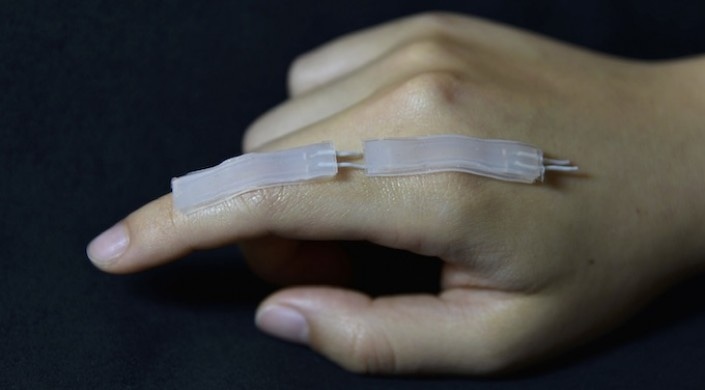Dec 24 2018
Cognitive and neuromotor developmental disabilities are common in children who are born prematurely. Therefore, catching those disabilities early through a series of motor and cognitive tests is the best way to minimize their impact.
 This biocompatible sensor is made from a non-toxic, highly conductive liquid solution that could be used in diagnostics, therapeutics, human-computer interfaces, and virtual reality. (Image credit: Siyi Xu, Daniel M. Vogt, and Andreas W. Rousing/Harvard SEAS)
This biocompatible sensor is made from a non-toxic, highly conductive liquid solution that could be used in diagnostics, therapeutics, human-computer interfaces, and virtual reality. (Image credit: Siyi Xu, Daniel M. Vogt, and Andreas W. Rousing/Harvard SEAS)
However, it is difficult to precisely determine and record the motor functions of toddlers. As any parent will vouch for this, small children generally do not like to wear large devices on their hands and have a penchant for ingesting forbidden things.
Now, researchers from Harvard University have created a soft and non-toxic wearable sensor that inconspicuously attaches to the hand and determines the motion of the fingers and hand and also the force of a grasp.
Reported in Advanced Functional Materials, the study is an association between The Wyss Institute for Biologically Inspired Engineering, The Harvard John A. Paulson School of Engineering (SEAS), Boston Children’s Hospital, and Beth Israel Deaconess Medical Center.
A non-toxic and highly conductive liquid solution is an innovative element of the sensor.
We have developed a new type of conductive liquid that is no more dangerous than a small drop of salt water. It is four times more conductive than previous biocompatible solutions, leading to cleaner, less noisy data.
Siyi Xu, Study First Author and Graduate Student, Harvard SEAS
A portfolio of intellectual property related to the design of new soft sensors has been filed by Harvard’s Office of Technology Development, which is also seeking commercialization prospects for these technologies.
The sensing solution is prepared from glycerol, which is a common food additive, and potassium iodide, which is a common dietary supplement. Following a brief mixing time, the glycerol forms iodide ions (I−) and potassium cations (K+) after breaking the crystal structure of potassium iodide and eventually makes the liquid conductive.
Since potassium iodide is highly soluble and glycerol is characterized by a lower evaporation rate than water, the liquid is highly conductive and is also stable across varying temperatures and humidity levels.
Previous biocompatible soft sensors have been made using sodium chloride-glycerol solutions but these solutions have low conductivities, which makes the sensor data very noisy, and it also takes about 10 hours to prepare. We’ve shortened that down to about 20 minutes and get very clean data.
Siyi Xu, Study First Author and Graduate Student, Harvard SEAS.
The sensors’ design also takes the children’s need into consideration. Instead of a large glove, the silicon-rubber sensor sits on the finger pad and on top of the finger.
“We often see that children who are born early or who have been diagnosed with early developmental disorders have highly sensitive skin,” stated Eugene Goldfield, study co-author and an associate professor in the Program in Behavioral Sciences at Boston Children’s Hospital and Harvard Medical School and Associate Faculty Member of the Wyss Institute at Harvard University. “By sticking to the top of the finger, this device gives accurate information while getting around the sensitively of the child’s hand.”
The Flexible Electronics for Toddlers project at the Wyss Institute designs modular robotic systems for small children who are born prematurely and face a risk of cerebral palsy. Goldfield is the main investigator of this project.
Along with his colleagues, Goldfield is now studying motor function using the Motion Capture Lab at Wyss and SEAS. Although motion capture can provide plenty of information about movements, it cannot determine force, which is important for diagnosing cognitive and neuromotor developmental disabilities.
“Early diagnosis is the name of the game when it comes to treating these developmental disabilities and this wearable sensor can give us a lot of advantages not currently available,” stated Goldfield.
This study has only tested the device on the hands of adults. Therefore, the team is planning to scale down the device and test it on the children’s hands.
The ability to quantify complex human motions gives us an unprecedented diagnostic tool. The focus on the development of motor skills in toddlers presents unique challenges for how to integrate many sensors into a small, lightweight, and unobtrusive wearable device. These new sensors solve these challenges—and if we can create wearable sensors for such a demanding task, we believe that this will also open up applications in diagnostics, therapeutics, human-computer interfaces, and virtual reality.
Rob Wood, Charles River Professor of Engineering and Applied Sciences, Harvard SEAS.
Wood, the senior author of the study, is also the Founding Core Faculty Member of the Wyss Institute.
The study was co-authored by Daniel M. Vogt, Wen-Hao Hsu, John Osborne, Timothy Walsh, Jonathan R. Foster, Sarah K. Sullivan, Vincent C. Smith, and Andreas Rousing. It was supported by the National Institutes of Health.
Biocompatible sensor
Safe, soft sensors on the top and tip of the index finger detect the movements, strain, and force of the finger while performing different activities, such as flexing and extending the finger and picking up weights and boxes. (Video credit: Siyi Xu, Daniel M. Vogt, and Andreas W. Rousing/Harvard SEAS)